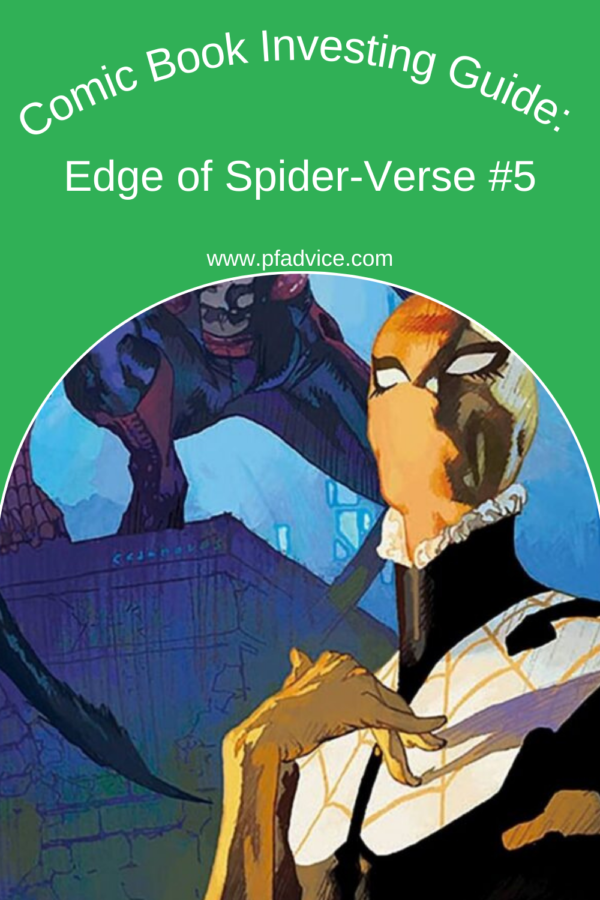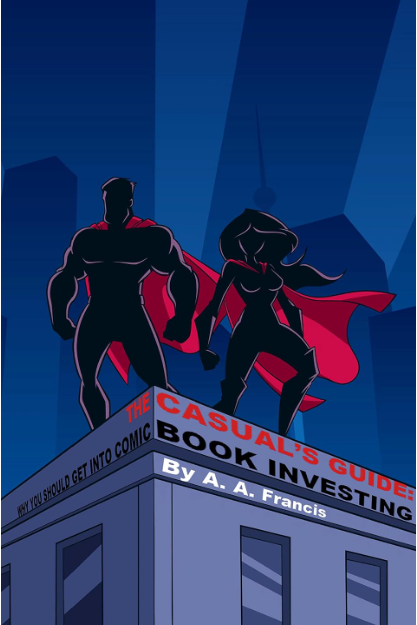Comic Book Investing Guide: Edge of Spider-Verse #5

(Image courtesy Famous Faces and Funnies FB)
If you are new to comic books, then there are several tropes and trends you must become familiar with. For one, it is very common to see variant versions of your favorite characters in their own comic books. Additionally, mega-corporations, such as Disney, recently accepted that they can widen their consumer base by adding more diversity to their characters and race-bending their majority white character lineup, especially in film adaptations.
So, if you are fond of aggressively pretending not to understand what “woke” means, reading Marvel Comics will infuriate you to no end. Edge of Spider-Verse (Vol. 2) #5 definitely ticks off these criteria.
Edge of Spider-Verse is a limited anthology series that teases an upcoming future storyline. In each issue, a variant, multiverse version of Peter Parker is introduced as the Spider-Man-like hero of their particular universe.
Edge of Spider-Verse #5 is most notable for introducing the first openly gay Spider-Man variant, Web-Weaver.
If that previous sentence made you want to write a letter to Tucker Carlson, then this comic book is not for you. If you are an open-minded casual reader, then you will be subjected to a mediocre story. If you think Edge of Spider-Verse #5 might be worth an investment, then you may be on to something.
This comic series features the first appearances of all new characters who may appear in other mediums in the future.
To keep track, it’s important to remember that every traditional Marvel comic book character you are familiar with inhabits the “616” universe.
What is important to keep in mind is that variant characters in comic books are not new. What is new is non-white and non-traditional versions of such characters appearing in mainstream comic books.
Edge of Spider-Verse #5 (But Why Tho?)
In the comic book world, writers and artists routinely swap out the main character with a variant or new hero to spice things up for a while. In a modern context, comic book companies are trying to accommodate different races of people who want to see themselves represented in these stories.
Over 86 percent of comic book characters are usually white and male. Additionally, the majority of iconic characters were created during the era of Jim Crow laws. Black Panther was created in 1966, over two years after Jim Crow laws were discontinued.
The point is that it is easy to feel oppressed if you’re used to most comic book characters being white and the paradigm shifts only a little bit. For example, actor Yahya Abdul-Mateen II, who portrayed Black Manta in the Aquaman film may soon portray Marvel’s Wonder Man, a character who is historically white.
However, for the last hundred years, white actors have regularly portrayed ethnic characters. Iconic actors John Wayne, Jerry Lewis, Katherine Hepburn, and Sean Connery have appeared in yellowface as if Asian actors didn’t exist.
Ra’s Al Ghul, an immortal Chinese Muslim man, and Batman villain was race bent into a white man portrayed by Liam Neeson for the 2005 film Batman Begins. Tilda Sweeney’s race and gender-bent the popular Marvel character the Ancient One, an ageless Tibetan sorcerer who mentored Dr. Strange, in the 2016 Dr. Strange film.
These are not the only examples of the few non-white characters in comics being race or gender-bent for white actors. The point is that if a gay Spider-Man variant infuriates you, keep that energy in other instances.
With that being said, Web-Weaver has a disappointing debut in Edge of Spider-Verse #5. The character is written as bad fan fiction employing every bad stereotype about the LBGTQ community. It’s an interesting premise that is annoyingly wasted in execution.
First Appearance of Web-Weaver
Edge of Spider-Verse #5 (October 2022) Marvel
Required Reading (If You Like)
This is ostensibly the final issue in a 5-issue anthology series. You don’t necessarily have to read the five previous issues to enjoy this issue.
However, if you plan to read the forthcoming comic book event featuring all of the characters introduced in these five issues, then all issues would be required reading.
Brief Bio and History
You’re already familiar with this concept if you saw the 2018 film Spider-Man: Into The Spider-Verse. In that film, the hero was Mile Morales, the Black and Latino version of Spider-Man who is aided by Spider-Men variants from other dimensions, including the original, Peter Parker.
However, in Marvel Comics, there is an interdimensional “web” of universes that link individuals who were granted their spider-based powers by a Spider-God via a totem. (Don’t worry, it’s over my head too.)
The point of these Spider-Verse issues is to go a little more in-depth exploring the lives of the Spider-Man variants we meet. And to introduce all-new Spider-Verse variant characters to the reader.
For example, Edge of Spider-Verse #1 features the first appearances of Spider-Laird and Spider-Rex. Spider-Laird is an 18th-century Spidr-Man fighting against British Redcoats. Spider-Rex is a dinosaur in prehistoric times with Spider-Man powers. In issue #2, we are introduced to Spd to Spider-UK, a black, female, Muslim, and English variant of Spider-Man.
I think you get the gist by this point.
In some future event, all of these characters will unite to stop a threat that threatens to destroy the “web” multiverse that connects them all.
And that brings us to Web-Weaver.
Edge of Spider-Verse #5 – The Review
This comic book is an anthology, so let’s start with the first story that features Hunter-Spider, who is Kraven the Hunter but with Spider-Man’s powers.
“Predator or Prey”
- Writer: Dan Slott and J. M. DeMatteis
- Artist: Bob McLeod
- Colorist: Jim Campbell
- Letterer: Joe Caramagna
What is important to remember is that in this series there is a unifying character who is traveling to each Spider-Verse universe to rally these characters to unite against a future threat.
In this story, we meet Sergei Kravinoff, also known as Kraven the Hunter, the iconic Spider-man villain. (Actor Aaron Taylor-Johnson will portray the character in a Kraven film soon to be released soon by Sony.)
Kraven is bitten by a spider monster while big-game hunting in Africa. He comes to New York City where he makes a deal to fight criminals because he wants new challenges.
All of the creators involved in this story are comic book industry veterans. Bob McLeod drew a lot of the comic books I read in my youth. Unfortunately, the story and character designs are laughably bad.
The costume created for Hunter-Spider is aesthetically laugh-inducing. And we don’t get to understand enough of his motivations.
I like the artwork and the colors in the comic, but they can’t save the story or hideous designs. Campbell shows his skill in coloring the African savannah at night while still using bright enough colors to show what is going on.
All involved in this comic book are industry veterans, but this story is obscenely bad.
“Counterfeit Catwalk”
- Writer: Steve Foxe
- Artist: Kai Zama
- Colorist: Brian Reber
- Letterer: Joe Caramagna
I heard about this issue and it struck me as a gimmick. The first only gay comic book character in Marvel comics was Northstar, a member of a Canadian superhero group Alpha Flight. And he came out in 1992.
Gay comic book characters are not new. What is new is the idea of writing them in a way where they are not walking stereotypes. (Read the legendary Batwoman comic run by Greg Rucka and J.H. Williams III from the early 2010s to see a lesbian character written without the emphasis being the character’s sexuality.)
Steve Foxe is an openly gay and noted author and comic book writer. I’m a hetero and cis male (if that is how the youngsters say it) so perhaps its east for me to criticize, but I couldn’t get past the lisping and sassiness of a gay character who also exclaims “Blessed Bea Arthur!” to appreciate the story.
In Earth-71490, Cooper Coen is a young gay man and fashion student who has a crush on Peter Parker. Coen pushes Peter out of the way when he notices a radioactive spider about to bite Peter. Coen is bitten and becomes Web-Weaver to fight crime.
Coen fights a Devil Wears Prada-type boss who also turns out to be the main villain. And all of this drama occurs during New York Fashion Week.
Web-Weaver’s costume design is interesting, but nothing the character does makes him stand out. (Like many of the other variants in this series) The way Web-Weaver’s mannerisms is drawn reminds me of Damon Wayans and David Alan Grier’s “Men on Film” characters on the 1990s comedy show In Living Color where they portrayed stereotypically over-the-top gay film critics.
Marvel recently published a comic book featuring a Black version of Thor that created a backlash. There were rapping birds, graffiti painted on Mjolnir, and tied sneakers hanging from powerlines. The writer, a non-black man, used every old stereotype to portray how they thought black people act in real life.
So, I hope I don’t come off as too critical or LGBTQ-bashing, which is not my intent. The point is that the fact Web-Weaver is gay is over-emphasized, while what makes him special or an interesting character is not.
There is a short panel that displays Coen’s origin that should have been further explored. Coen was run out of his family home and raised by aunts that accepted Coen out of familial love. And it was in that loving family environment that Coen learned to value himself and become a superhero.
I wished this story expanded on that panel.
On one page, Coen is on a date with a man who says Coen is a mystery. Coen replies “I don’t know about all thaaaaat.” implying the sassy lisp, a common stereotype. (Which this comic is full of.)
Foxe’s writing is generic and stereotypical. Web-Weaver acts like a contestant from a Drag Race episode becoming a superhero, and not about a superhero who happens to be gay. Zama’s art is serviceable, but not memorable.
Verdict – Buy It or NOPE
I find it hard to recommend Edge of Spider-Verse #5. But it is not because of Web-Weaver – I find the whole series unremarkable.
And there is too much emphasis on introducing new Spider-Man variants instead of showing what makes them important or interesting. The overarching threat to the “Web” is never fully explained in a way that makes you care.
In the first issue, Spider-Laird battles recoats who are stealing his livestock. And we are introduced to Spider-Rex, a red and blue dinosaur with Spider-man’s powers. I’m shocked that we haven’t met “Caveman Spider-Man” or “ Stoner Spider-Man,” by now.
Your enjoyment as a reader will vary. I did not enjoy it. Foxe wasted an incredible opportunity to create a new iteration of Spider-Man with their own agency, motivations, and adventures.
Still, this is the first appearance of the first openly gay Spider-Man character, so that might make it worth your while to invest in it as a collectible.
Edge of Spider-Verse #5 – Current Market Value
This comic book has a cover price of $4.99. But it also currently has a collectible market value price of $58.25 for issues with a 9.8 CGC grade.
This is volume two of a comic book series designed to introduce new variants of SpiderMan. If I were you, I would buy this comic as a collectible investment.
Spider-Gwen, also known as Ghost-Spider, was a major character in 2018’s Into the Spider-Verse. Spider-Gwen made her first appearance in the 2014 comic book Edge of Spider-Verse #2 (Volume 1). It has a $3.99 cover price. If you have an issue with a 9.8 CGC grade, it is worth $1,150. (Who said new comics are valuable?)
Do you have a copy of Edge of Spider-Verse #2 (Volume 2)? This comic was published in February 2022. It features Spider-Gwen but it also features the first appearance of Spider-UK. It now has a current market value of $1,160 if you have a 9.8 CGC graded copy.
(These estimations are based on actual sales.)
A copy of Edge of Spider-Verse #5 (Volume 1) from 2014 is worth $2,163. And someone paid for an issue with only a 9.2 CGC grading.
So, yes, Edge of Spider-Verse #5 (Vol. 2) is not a good comic. It was a chore to read. But there is a vocal fanbase of readers who love and collect these comics. And the characters featured in this second volume may appear in films and TV in the near future, increasing their popularity. I think it is worth an investment because a future collector may covet it based on past collectible investment behaviors of earlier volumes.
Read More
Comic Book Investing Guide: Thunderbolts #3
Comic Book Investing Guide: Gunslinger Spawn #13
How Much Does It Cost To Get a Comic Book Graded?

Allen Francis is a full-time writer, prolific comic book investor and author of The Casual’s Guide: Why You Should Get Into Comic Book Investing. Allen holds a BA degree from Marymount Manhattan College. Before becoming a writer Allen was an academic advisor, librarian, and college adjunct for many years. Allen is an advocate of best personal financial practices including saving and investing in your own small business.

